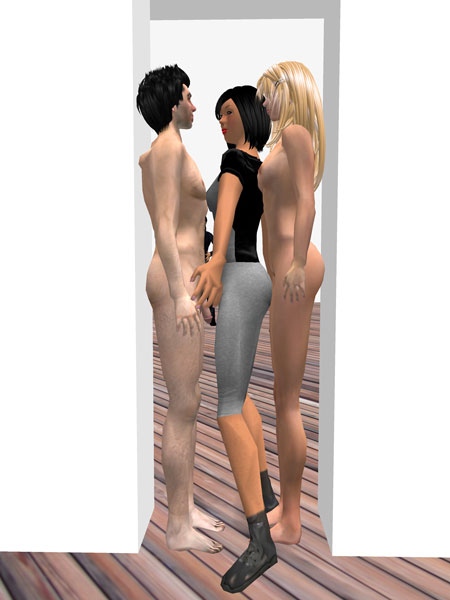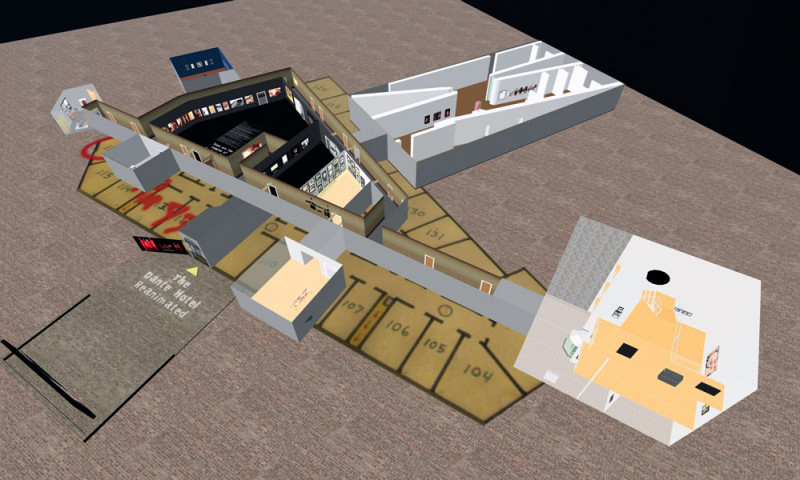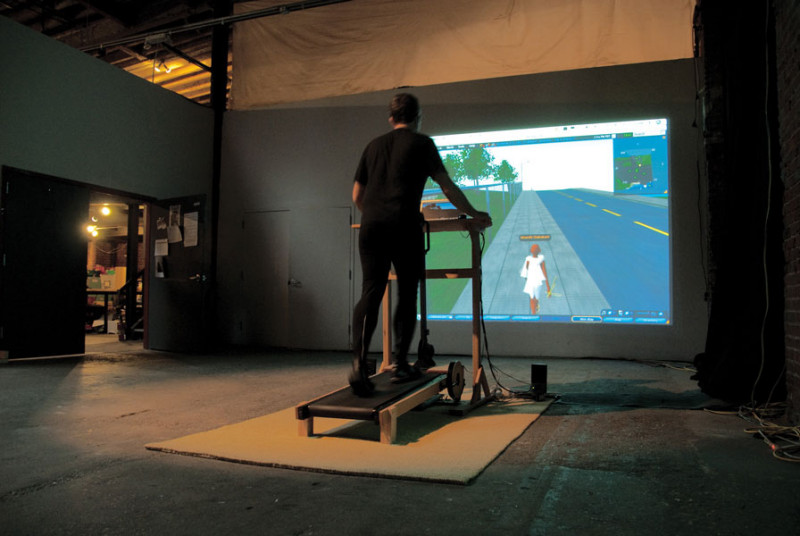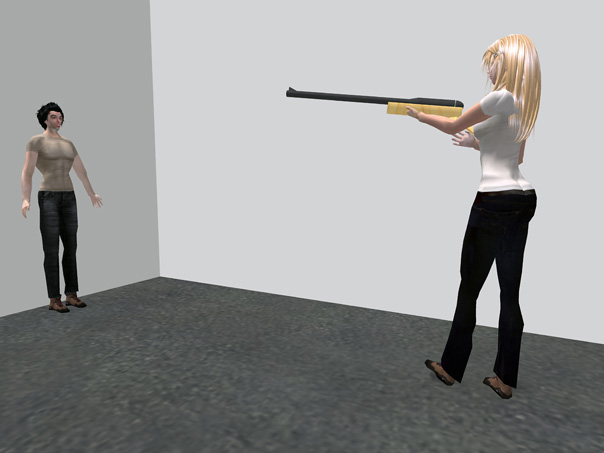[Fall 2010]
by Cyril Thomas
Displacement and Inversion in SecondLife: From Action to Perfor-mance, from Performance to Action
In 2007, the Italian couple Eva and Franco Mattes, better known by a pseudonym (that corresponds to the URL of their Web site: http://www.0100101110101101.org/), executed a performance originally given in July 1977 by Marina Abramovic and Ulay, titled Imponderabilia, at the Galleria Comunale d’Arte Moderna di Bologna. The reinterpretation was on view at the 2008 Festival Exit at the Maison des Arts de Créteil. This Web performance was simply a preview; it was part of a larger project begun in 2007, Synthetic Performances.7 These “republications” of performances nevertheless raised some questions: what about the viewer who sees the video of something taking place on the Web? What about SecondLife participants? Which archives, commentaries, or accounts do the artists use to formulate the framework for their performances? Is there not a loss when performances that had a transgressive meaning or an obvious value are reiterated?
A priori, reviving a performance (live, for those who are lucky enough to be connected to SecondLife) might dilute the initial gesture of artists who had theorized and anticipated the post-performance period by either preserving texts or assembling documents (usually photographic and sometimes videographic). Most viewers saw only the documentation at a subsequent exhibition. Some of these documents became archives of the performance and were then used as sources.
The reactivation of the past gesture may also subvert the initial performance by abolishing the site, the gallery, or the museum. One may simply compare the video of Chris Burden’s performance Shoot8 and the 2007 video Reenactment of Chris Burden’s Shoot by Italian artists Eva and Franco Mattes. They were not trying to faithfully reproduce the original. In fact, titles in the original film that mention the place and the date, “November 19, 71,” have completely disappeared, as have the intertitles, even the last one (“Empty shell dropping on concrete floor”), which permitted viewers to come to a conclusion about the after-effect of the shot – that is, the concept of a sculptural instant linked to the impact of the bullet. In the recent reprise, the mise en scène of the male and female avatars takes precedence over the perfor-mance. The idea is confirmed in the Matteses’ work Reenactment of Gilbert & George’s The Singing Sculpture. In this displacement into SecondLife, the symbolic scope, manifestly linked to the sculpture,9 the role of the pedestal, the play with the props, and the repetitions of the piece by the original artists, Gilbert Proesch and George Passmore (known as Gilbert & George), seem to have disappeared. In SecondLife, everything seems flattened, levelled by successive interventions. The Matteses, who manipulate the avatars, simply “play” in a space partway between the podium and the theatre stage.
In short, the entire history of the performance by Gilbert & George is wiped away in favour of an action (and not a performance), an imitation that could be likened to a wink or a parody. Even though there is no doubt about the sincerity of the approach in Synthetic Performances, it can also be analyzed in terms of influence (a notion dear to a certain art-historical critical stream), placing Eva and Franco Mattes in the realm of contemporary art rather than media art. However, even though their works address a deviation, a shift between the notion of action and that of performance, a problematic point remains. The displacement or transfer of a performance into an action (which, through the title and some of the gestures, evokes performance) erases the referential and historical aspect.
Another example is Joseph DeLappe’s work, based on Gandhi’s famous 1930 Salt March.10 This multiform, complex project (it gave rise to sculptures, to other SecondLife performances in 2009, and to other pieces), is summarized in the reiteration of the march in the virtual universe (from 12 March to 5 April 2008). An apparatus created by the Eyebeam Art and Technological Center in New York was used to transpose the steps physically taken by DeLappe (and those of spectators invited to use it) into SecondLife. However, by refusing to press the “fly” button (the most classic form of travel in this virtual world) for his avatar named MGandhi Chakrabarti, DeLappe signified Gandhi’s physical action within this meta-universe; he performed it. He updated the historical gesture by tipping it into performance in order to bring politics and history into a virtual universe that seems not to have any. With this reiteration, a conceptual displacement of action to performance (that is, a movement in the opposite direction than that taken by the Matteses), he introduces a “performative archive” of protest and politics within the very core of SecondLife.
Reiterating to Rewriting: SecondLife as Palimpsest
Beyond reiteration and monstration on a single screen, some artists, including Lynn Hershman Leeson,11 envisaged a true rewriting of a past work, but taking account of the site of monstration: at once in an exhibition space, in SecondLife, and in a personal museum archive also available in SecondLife. Although the island set up by the researchers at the Stanford Humanities Lab12 for Hershman Leeson’s archives has evolved considerably over three years, it seems that a completed form has existed since 7 January 2010.
Hershman Leeson first designed an installation, Life Squared, presented in the exhibition “Les vases communicants-e-art,” in Montreal in 2007.13 The installation was intended as a sort of remake of a performance produced at the Dante Hotel in 1973–74 – a remake conceived by displacing archival elements into the space of SecondLife. The scenography of this installation (which represented only some of the artist’s works presented during the exhibition) and ensuing ones were modelled within SecondLife, thus blurring somewhat the paths for viewers who did not know whether, in SecondLife, they were seeing a mock-up of the scenography that was to be used for the Montreal exhibition or a reconstruction after the fact of the scenography in SecondLife.
Three years later, the question remains open, but further questions arise about the monstration, and about the very architecture of the site. In effect, in 2007, two distinct spaces provided a separation between the purely archival part (most of which was devoted to the construction and formulation of the artist’s double, named Roberta Breitmore, the fabrication of false identity papers, and the disguise process, including the blond wig to be worn, the gestures to use, and the make-up to be applied) and the part linked to the modelling of the Dante Hotel (done with the assistance of several photographs). To these two pieces were added the reconfiguration and modelling of the scenographic space of the museum in Montreal, which brought into play a sort of third building that avatars could easily access. Currently, a much more coherent grouping, which includes the above elements, forms a single building divided into a number of rooms that allow the archives to be accessed. Thus, viewers find Room No. 47 of the Dante Hotel, embellished with a documentary and several modelled objects; three different rooms are added: first, The Archive Reanimated, Life Squared, Roberta Breitmore; second, The Archive Reanimated, Life Squared, Dante Hotel; third, SF Moma, Life Nth, which corresponds to different photographic archives. And then there are the halls devoted to other exhibitions.
A Transfer of History or a Transfer of Stories?
Even though the project in SecondLife, as well as the larger Life Squared project, is directly linked to the donation of Hershman Leeson’s archives to a specific institution, access to the collection is controlled by the artist down to the last detail. A hypothesis thus arises: the artist uses SecondLife to reiterate and complement the biography of her double, Roberta Breitmore, which she featured in performances, works, and writings from 1974 to 1978. Thus, she makes the Dante Hotel the birthplace and point of departure of performances featuring her double. The name of her avatar, Roberta Ware (wares in the sense of merchandise; in this case, archaeological or archival merchandise), adds another facet. The creation – or, more precisely, the birth and arrival – of Roberta Breitmore in San Francisco in the 1970s and how her polymorphous activities began remain a sort of mystery. This part of her story is almost completely missing, as opposed to the rest of her life, which is very well documented. In fact, through SecondLife, Hershman Leeson rewrote part of the biography of her double, Roberta Breitmore, by giving her a real starting point: when she arrived in San Francisco, she moved into the Dante Hotel. This anchoring, imbued with fiction, justifies in part the care taken in the choice of archives, both video and photographic, available in SecondLife, sometimes breaking the link between documents and works, between the reinterpretations and the rewritings of her own career – or, at least, the performance career of Roberta Breitmore.
For Hershman Leeson, it is not a question of moving between action and performance, but of activating the archive so that it is not simply a memorial trace but a complement, a full production, integrated into a particular artistic production that allows both reinterpretation and reappropriation of the original materials in order to reactivate certain performances interpreted by her, or by a curator, or by another person made up to look like Roberta Breitmore, but above all to create a continuity. It is a red line, almost a narration, that uses many of her pseudonyms and doubles to erase chronological approximations and form a major monograph on most of her performances. Thus, the reiteration intervenes in the reactivation of past performances that form the subtext for a more complex, global work that fictionalizes her artist’s biography a bit further – a fiction that is formulated by, in, and through the selection of scenographic archives, some of them modelled in SecondLife.
Translated by Kâthe Roth
1 See Charlotte Nunes’s interview with Nonny de la Peña and Peggy Weil at http://currents.dwrl.utexas.edu/2010/delaPena-Weil_Gone-Gitmo.
2 See Paul Sermon’s Web site, http://creativetechnology.salford.ac.uk/paulsermon/liberate/.
3 See Agnès de Cayeux’s Web site, http://www.agnesdecayeux.fr/. The Alissa project may be viewed on the virtual space at the Jeu de Paume Web site: http://lemagazine.
jeudepaume.org/2010/05/agnes-de-cayeux/.
4 See Nicolas Boone’s Web site, http://www.nicolasboone.net/.
5 For an approach that is historical rather than artistic, see Agnès De Cayeux and Cécile Guibert (eds.), Seconde Life, un monde possible (Paris: Éditions les Petits Matins, 2007).
6 Cf. Brian O’Doherty and Patricia Flaguières, White Cube. L’espace de la galerie et son idéologie (Zurich: Éd. Jpr Ringier, 2008).
7 See the interviews with the artists: www.0100101110101101.org/home/reenactments/interview.html.
8 A number of excerpts are available on the Web. See Peter Noever (ed.), Chris Burden, Beyond the Limits (Cantz: MAK, 1996), p. 193; Kristine Stiles, Robert Storr, Paul Schimmel, and Fred Hoffman, Chris Burden (London: Thames and Hudson, 2006).
9 See the four pages titled A Guide to Singing Sculpture, reproduced in Carter Ratcliff and Robert Rosenblum, Gilbert & George: The Singing Sculpture (London: Thames and Hudson, 1993), p. 37; “The Singing Sculpture: Interview with Wolf Jahn” (1995) in Hans Ulrich Obrist and George Gilbert, The Words of Gilbert & George (London: Thames and Hudson, 1997), pp. 239–52.
10 Cf. http://www.unr.edu/art/delappe/DeLappe%20Main%20Page/DeLappe%20Online%20MAIN.html and http://www.brooklynrail.org/2008/04/artseen/joseph-delappe-gandhis-march-to-dandi. See also Lizbeth Goodman and Denise Doyle, Kritical Works (Wolverhampton, UK: University of Wolverhampton, 2009) pp. 27–29.
11 M. Tromble (ed.), The Art and Films of Lynn Hershman Leeson: Secret Agents, Private I (Berkeley and Seattle: University of California Press and Henry Art Gallery, 2005). See also the blog devoted to Hershman Leeson’s news: http://lynnhershman.com/livingblog/; Amelia Jones, “This Life,” Frieze, available at http://www.frieze.com/issue/article/this_life/; and, especially, “Lynn Hershman Leeson in Conversation with Gabriella Giannachi,” Leonardo, vol. 43, no. 3 (June 2010): 232–33.
12 Cf. www.stanford.edu/group/shl/cgi-bin/drupal/?q=node/31.
See also the transcription of an interview between Hershman Leeson and Michael Shanks: http://documents.stanford.edu/michaelshanks/254.
13 http://www.fondation-langlois.org/e-art/f/lynn-hershman.html.
Cyril Thomas is a doctoral student at Université Jules Verne in Picardie and at Télécom ParisTech, and a member of the Centre de Recherches en Arts. He is editor-in-chief of the trilingual (French, English, Dutch) magazine Transdigital.






